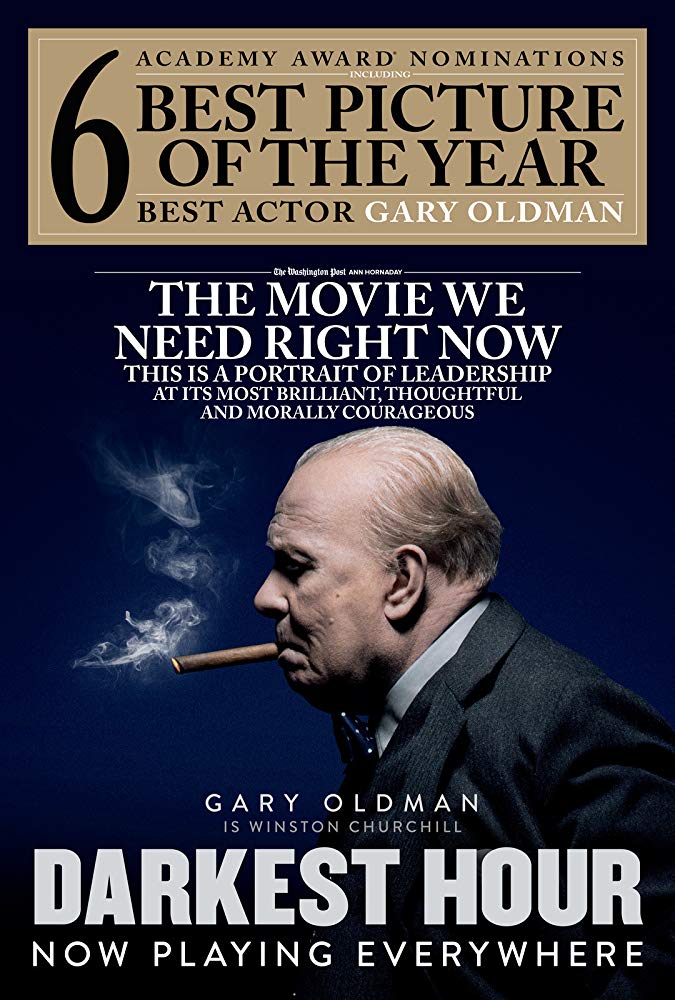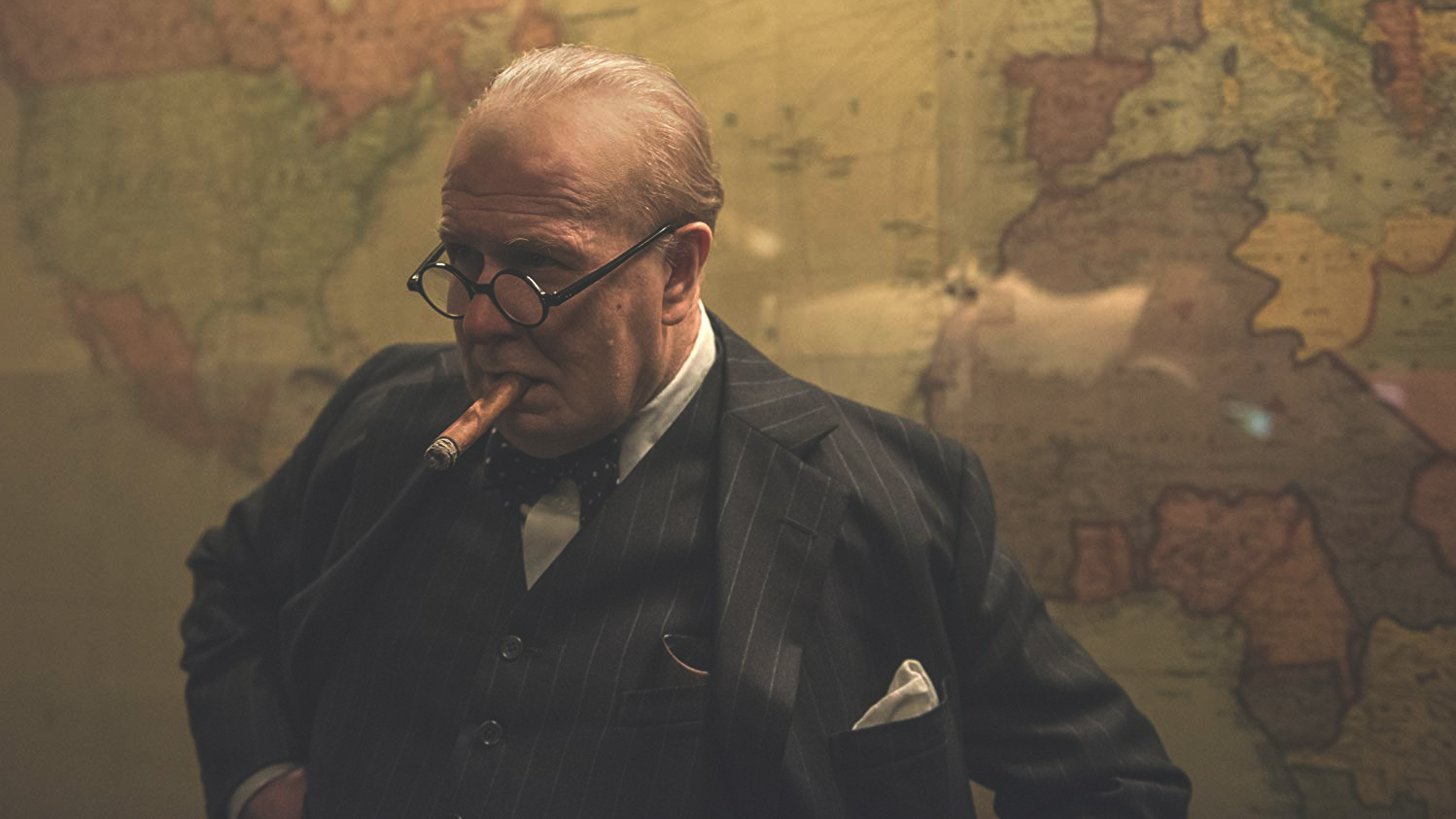Darkest Hour (2017)
Film and Plot Synopsis
Darkest Hour begins with Great Britain in the grips of the second World War. The nation is torn between standing up to the Nazi threat or suing for peace. Winston Churchill is elected as Prime Minister with as many people rooting for his failure as they are for his success. Although a man of firm convictions, Churchill begins to question the correct course of action as well as his own beliefs just as the threat to England becomes even more dire.
‘Darkest Hour’ Movie Summary
 Darkest Hour takes place during the darkest days of World War II. The opposition Labour Party in British Parliament demand the resignation of Prime Minister Neville Chamberlain (Ronald Pickup) after he is perceived to be weak in his handling of Adolf Hitler and the Nazi army. With deep political discord in Parliament, Chamberlain is forced to choose the only man whom the opposition parties will accept, Winston Churchill (Gary Oldman).
Darkest Hour takes place during the darkest days of World War II. The opposition Labour Party in British Parliament demand the resignation of Prime Minister Neville Chamberlain (Ronald Pickup) after he is perceived to be weak in his handling of Adolf Hitler and the Nazi army. With deep political discord in Parliament, Chamberlain is forced to choose the only man whom the opposition parties will accept, Winston Churchill (Gary Oldman).
Churchill is a difficult man to work with. He tries to dismiss his new secretary Elizabeth Layton (Lily James) on her first day on the job, which results in a dressing down from his wife Clementine (Kristen Scott Thomas). As per protocol, Churchill goes to Buckingham Palace to meet with King George VI (Ben Mendelsohn) to ask for permission to form a government with Churchill as Prime Minister. There is tension between the King and the Prime Minister due to Churchill supporting the King’s brother Edward VIII during the Abdication Crisis of 1936.
Churchill forms his government and includes Chamberlain and Viscount Halifax (Stephen Dillane), two of his political enemies, on his war council. Chamberlain and Halifax are dismayed at Churchill’s refusal to engage in peace negotiations with Germany, and begin to plan to resign from the government to force a vote of no confidence in Churchill. The pair believe with Churchill out of the way, Halifax will likely be the next prime minister.
One of his first acts as Prime Minister is to meet with the French Prime Minister Paul Reynaud (Oliver Broche). Reynaud believes that Churchill is delusional for not admitting that the Allies are losing the Battle of France, while Churchill is furious that Reynaud has no plan for counterattack against the Germans. When Churchill tries to seek assistance from the United States, a sympathetic Franklin D. Roosevelt (David Strathairn) tells him his hands are tied by the isolationist policies of the U.S. Congress.
In a plan to maintain public support, Churchill draws criticisms for delivering a radio address in which he falsely implies the Allies are winning the war. In reality, British forces are in heavy retreat and are currently trapped in both Dunkirk and Calais. If Churchill does not find a way to get the nearly 300,000 men out of Dunkirk, the British army will be virtually wiped out leaving Great Britain vulnerable to invasion.
Halifax and Chamberlain try to convince Churchill to use the Italians as an intermediary to negotiate with Germany for peace, but Churchill refuses to consider the option. Additionally, Churchill disregards the advice of his War Cabinet and orders Brigadier Claude Nicholson in Calais to lead his forces in a suicide rear guard action to distract the German forces and buy some time for the soldiers at Dunkirk to evacuate.
With things continuing to worsen in France, the War Cabinet continues to strongly push Churchill to sue for peace. Under heavy pressure and uncertain as to what is the best course of action, Churchill agrees to consider a negotiated peace. Churchill is visited by the King who tells him that despite their past, he has come to like Churchill and encourages him to continue the war. The King tells him to listen to the people.
The next day, Churchill impulsively rides the London Underground and asks the startled passengers their opinions as to what Britain should do in the war. Surprisingly, the civilians encourage Churchill to fight no matter the cost. Embolden by the public support, Churchill meets with the Outer Cabinet and other members of Parliament who also support Churchill in his plan to continue the fight with Germany. At almost the same time, Churchill receives word that Operation Dynamo, a plan that Churchill implemented to rescue the 300,000 men stranded at Dunkirk by using hundreds of small, civilian water craft, has been successful, thus saving the British ground forces.
With Churchill preparing to address Parliament to publicly announce his intentions to continue the war, Halifax pushes Chamberlain to continue with their plan to resign. However, Chamberlain decides to listen to Churchill’s address first before committing. Churchill gives his famous “we shall fight on the beaches” speech to rousing support and applause, including that of the Opposition Party. Chamberlain decides to give into Churchill and the Tories join in their support of Churchill’s plan. When the speech is over, Churchill leaves Parliament in loud applause.
The post script at the end of the film indicates that nearly all of the 300,000 allied soldiers are rescued in Dunkirk; Chamberlain died of cancer six months later while Halifax would be dismissed from the war cabinet and appointed as Ambassador to the United States; and that the Allies finally defeated Germany in May 1945, after which Churchill was voted out of power in the general election.
Add the film to your collection today!
Additional Film Information
- Darkest Hour official website
- Peruse IMDb’s article on Darkest Hour
- Learn more Darkest Hour information at Wikipedia
- Get Darkest Hour numbers at Box Office Mojo
- Find out what people think about Darkest Hour at Metacritic
- Read Darkest Hour reviews from the folks at Rotten Tomatoes
Rate the Film!
Our Rating
Our Rating
Focus Features released Darkest Hour on December 22, 2017. Joe Wright directed the film starring Gary Oldman, Lily James, and Kristen Scott Thomas.
